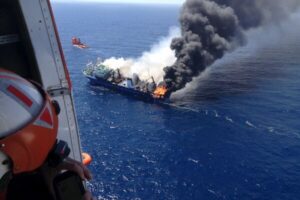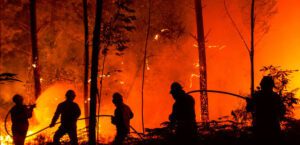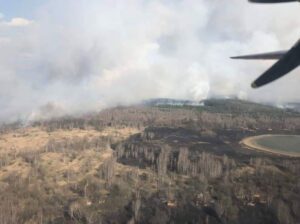
Ukraine has announced an international tender for the purchase of a modern multifunctional vessel for Danube ports, which will perform environmental, emergency rescue, and technical tasks.
According to a statement by the State Enterprise “Ukrainian Sea Ports Authority” (USPA), the vessel will be designed to operate in the ports of Izmail, Reni, and Ust-Dunaysk, which are currently key logistics hubs in the south of the country.
According to the technical specifications, the new vessel will be able to collect oil products and debris from the water surface, extinguish fires on ships and port facilities, and perform tugboat and mooring functions, assisting large ships in maneuvering.
The project is being implemented as part of the RELINC (Restoration of Essential Logistics Infrastructure and Network Connectivity) program with the support of the International Bank for Reconstruction and Development (IBRD).
Experts note that the new vessel will not only strengthen the port infrastructure, but will also be an important element of the environmental safety of the entire Danube.
Danube ports currently handle more than 40% of all Ukrainian agricultural exports and play a key role in international logistics, especially after the blockade of Black Sea routes.
The Danube is approximately 2,850 km long, the second longest river in Europe after the Volga.
The river basin flows through 10 countries — Germany, Austria, Slovakia, Hungary, Croatia, Serbia, Romania, Bulgaria, Moldova, and Ukraine — and flows into the Black Sea through the Danube Delta, part of which is located in the Odesa region.
According to estimates by the European Commission and the International Commission for the Protection of the Danube River (ICPDR), the level of pollution in the river remains moderate, but there is an accumulation of heavy metals, pesticides, and microplastics, especially in the tributaries.
The main sources of pollution are industrial discharges, agrochemicals, household waste, and shipping.

In recent days, Europe has been covered by a wave of abnormal heat, which has led to forest fires in many southern countries, Western media reported on Wednesday.
The Portuguese authorities said that several fires led to the evacuation of about 700 people, about 120 needed medical attention, one local resident and one firefighter were seriously injured. 1,300 firefighters and several water-dropping aircraft were sent to fight the elements in the central region of the country, while about 1,000 firefighters are working in other regions.
In the southwest of France, a forest fire has engulfed an area of more than 1.2 thousand hectares near the commune of La Teste-de-Bouche, which is located south of Bordeaux. On Wednesday morning, about 6,000 people were evacuated from the area. Also, about 500 people were evacuated from the outskirts of the city of Landira. More than 800 firefighters are fighting fires in France.
The flames continue to be fought in Italy, which this summer faced the worst drought in 70 years. Firefighters are fighting a fire near Bolzano on Tuesday afternoon and a fire in Tuscany on Wednesday morning. Two helicopters and six teams of firefighters were sent to fight the second.
In Spain, abnormal heat is recorded in all regions, in some the temperature reached 44 degrees Celsius. In the west of the country, a forest fire destroyed 3.5 thousand hectares of land, more than 450 people were evacuated.
A forest fire was also recorded in southwestern Turkey near the resort of Datca on the Aegean Sea. At least nine water-dropping helicopters and five planes were dispatched to fight the fire.
In 2021, many European countries were also seriously affected by forest fires, which were the result of abnormal heat. Then a difficult situation with natural fires was observed in Greece, Italy, Turkey, Montenegro, Algeria and North Macedonia.

Fires near the Chornobyl nuclear power plant cannot be completely extinguished, and some increase in cesium concentrations has been recorded in Kyiv and west of Chornobyl, the International Nuclear Energy Agency (IAEA) said, citing the State Nuclear Regulatory Inspectorate of Ukraine.
“Ukraine’s regulatory authority informed the IAEA that firefighters were trying to extinguish wildfires near the Chornobyl NPP, an area which has seen such outbreaks also in previous years. The fire brigade from the town of Chornobyl has extinguished four fires, but there are still ongoing fires,” the IAEA said on its website on Wednesday in the evening.
According to the release, the local fire station does not currently have access to the electricity grid, the regulator said. In the meantime, the station is relying on diesel generators for power, for which fuel is required, it added.
The IAEA also draws attention to the fact that, in the Exclusion Zone, the regulator said radiation measurements are not currently being performed. It said slight increases in caesium air concentrations had been detected in Kyiv and at two NPP sites west of Chornobyl, but the regulator told the IAEA that they did not pose significant radiological concerns.
At the same time, in a video message posted on the IAEA website on Wednesday, IAEA Director General Rafael Mariano Grossi called the situation when major nuclear facilities operate in an armed conflict zone “dramatic and unique,” and noted that the situation remains distressing, and “the need to prevent a nuclear accident becomes more pressing with each day that passes.”
According to him, “intensive consultations have been ongoing for many days now, but a positive outcome still eludes us.”